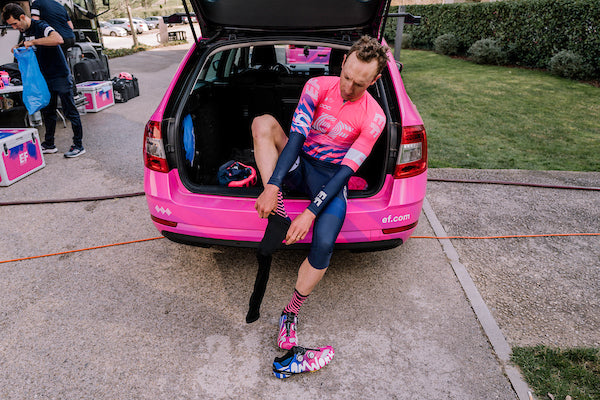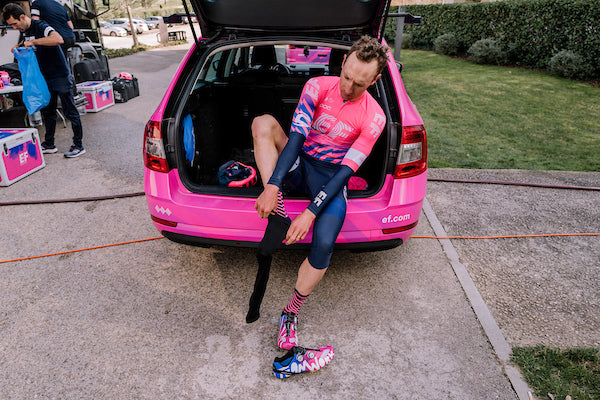If you've ever had a sports injury, you will have heard the term RICE. It stands for Rest, Ice, Compression, Elevation. What you might not know is that Dr. Mirkin, the doctor who created the original RICE protocol, now says he was wrong and that both ice and rest may delay recovery.
Instead, healing requires increased blood flow so that cells and proteins can enter the damaged area and start to do their repair work. Incrediwear does just that: our sleeves and braces reduce swelling by increasing blood flow, speeding up the recovery process. Pros on the EF Education First Pro Cycling Team know this and are now all using Incrediwear to recover from muscle fatigue, overuse injuries, and crashes.

EF Pro Cycling Rider, Mike Woods, taken by Jojo Harper
Cycling is a very safe and healthy activity — unless, of course, you’re a professional racer. Endurance athletes, like cyclists, are three times more likely to experience overuse injuries than those in strength sports.
Plus, they have the added risk of traveling at super high speed on dangerous roads in incredibly close proximity to other athletes. It all adds up to a long list of dangers, and, unfortunately, pro cyclists spend a large part of their career recovering from injury.
The good news is that Incrediwear is changing the game with 46% faster recovery times than conventional treatments. Reducing or eliminating inflammation before it starts allows the increased blood flow to target cells that need oxygen and nutrients to rebuild tissue quickly.
What Can You Do If You’re Also Injured?
Here is an injury recovery protocol that begins with four basic steps.
1) STOP THE SWELLING
Depending upon the type of injury, controlling inflammation hastens healing, so your first response should be to reduce or eliminate swelling before it starts. That said, ice is a bad idea. It has been proven to delay healing and interfere with athletic performance, along with some other potentially harmful side effects.
Instead, use an Incrediwear sleeve, which has the semiconductors germanium and carbon embedded in the fabric. It cools the body and limits vasodilation, which causes flooding in the tissue and, consequently, swelling.
The mid-level infrared waves released by Incrediwear’s fabric push the tissue swelling into the lymphatic system to minimize heat buildup, swelling, and blood pooling.

EF Pro Cycling Team Rider, Rigoberto Urán, with Incrediwear Founder, Jackson Corley. Taken by Jojo Harper.
2) SEEK PROFESSIONAL ADVICE
If you don’t know, or if you're speculating what kind of injury you have, you may risk further injury if you’re treating yourself incorrectly. A professional will be able to accurately assess your injury and put you on the right road to recovery.
3) EDUCATE YOURSELF
Once you know what your injury is, educate yourself about it. Learn its causes, its treatments, and most importantly, how to prevent it from happening again. With overuse injuries related to cycling, it’s essential to evaluate your bike as well since many overuse injuries can result from a poor bike fit.

Distance runner Emily Trost getting some much needed recovery in with the Incrediwear Ankle Sleeves
4) LISTEN TO YOUR BODY
Learning to listen to your body is key to any successful injury recovery plan. Tuning into your physical sensations should become a habit whether you’re injured or not since listening to your body will give you valuable feedback so that you can perform better. Doing too much too fast can lead to re-injury, so know your limits and when to hold back to prevent further injury from happening.
What Is the Healing Phase of Injury Recovery?
There are a couple of goals you want to aim for during the healing phase of recovery. Increasing your range of motion and rebuilding strength around the injured area is one of them.
Your body heals best when in motion; mobility promotes blood flow, and increased circulation helps bring more oxygen and nutrients to the target area, which optimizes the body’s natural healing process and accelerates recovery.
The proprietary fabric technology in all of Incrediwear’s recovery products, including the knee sleeve, hip brace, and leg sleeve, is embedded with semiconductor elements that emit infrared waves when stimulated by body heat. These infrared waves create cellular vibrations that increase blood flow and speed. This means your body benefits from increased circulation even while at rest with Incrediwear.
Physical therapy, under the guidance of a physiotherapist, is integral in the recovery journey. Tailored range of motion exercises aid in rehabilitating the injured area, promoting increased flexibility and preventing future injuries. Orthopedic specialists often recommend strength training as part of a rehabilitation process, emphasizing the need for a gradual return to activity to avoid re-injury.
Incorporating some cold therapy, such as ice packs, for specific durations contributes to managing inflammation without compromising the overall recovery time. Using splints and braces at the recommendation of orthopedic doctors may also be useful for supporting injured tissues.
Additionally, considering mental health aspects during the recovery phase is of the utmost importance due to the interconnectedness of physical and psychological well-being.
Ultimately, you’re in charge of your recovery, and there are a few things you can proactively do on your own to aid your recovery.
These include:
- Getting a minimum of eight hours of sleep
- Minimize inflammation further with an anti-inflammatory diet
- Improve your muscle mobility with specific exercises designed to mobilize tight muscles that restrict movement and impair your performance.
Dedicate yourself to your recovery. Any athlete can tell you about marginal gains related to sports performance, even if your rehab seems monotonous at times, marginal gains related to recovery add up over time until you are fully recovered.
What Is the MEAT Recovery Method?
The MEAT (Movement, Exercise, Analgesics, Treatment) recovery method presents a dynamic alternative to the conventional RICE protocol for injury recovery. Focusing on a comprehensive approach, MEAT integrates movement, targeted exercises, pain management, and specialized treatments to optimize rehabilitation and expedite the healing process.
Movement
In the MEAT recovery method, movement is a pivotal phase that defies the traditional notion of complete rest. Controlled and gentle movements are encouraged to stimulate blood flow, prevent stiffness, and enhance the body's natural healing mechanisms.
Incorporating low-impact activities tailored to the specific injury, such as joint rotations and controlled stretches, fosters a proactive approach to recovery. This emphasis on movement aligns with the understanding that immobility can hinder the restoration process, making controlled activity an essential component of the MEAT method.
Exercise
The exercise phase within the MEAT recovery method plays a pivotal role in targeted rehabilitation. By incorporating specific exercises tailored to the nature of the injury, individuals can enhance flexibility, build strength, and improve range of motion.
Professionals design these exercises to address the unique needs of each injury, promoting a gradual and progressive recovery. Whether through resistance training, stretching routines, or stability exercises, the exercise component of MEAT aims to restore functionality and prevent future issues by addressing the root causes of the injury.
Analgesics
Analgesics, a key aspect of the MEAT recovery method, are employed to manage pain effectively. This phase involves the careful use of both over-the-counter and prescribed pain relief medications. While analgesics can provide relief, it's crucial to consult with healthcare professionals before incorporating them into the recovery plan.
Striking a balance between pain management and avoiding potential side effects is essential. The analgesic phase within MEAT ensures that individuals can comfortably engage in movement and exercise without being hindered by excessive pain, contributing to a more holistic and patient-centered recovery approach.
Treatment
The treatment phase in the MEAT recovery method encompasses a range of therapeutic interventions tailored to the individual's injury. From physical therapy and targeted massage to specialized treatments, this phase aims to address the root causes of the injury and expedite healing.
With a focus on personalized care, individuals benefit from a comprehensive treatment plan that aligns with the specific nature and severity of their condition. MEAT's treatment phase underscores the importance of a nuanced and individualized approach to rehabilitation, ensuring optimal recovery outcomes.
How Can You Prevent Future Injuries?
Only when you’re injured can you truly appreciate what it feels like to be healthy. Put another way, once you recover from an injury, you’ll do almost anything to keep yourself from getting injured again.
Here are some more preventive measures to help you do that:
- Don’t rush your recovery – Instead of focusing on your end goal to get back on the bike (or back out on the field), take the time to heal, be patient, and stay focused and positive – injury recovery is a process.
- Minimize future risk – Identify mistakes that led to your injury and implement a prevention plan for both training and racing.
- Get your bike fitted – A proper bike fit is the most common recommendation for avoiding overuse injuries.
- Stretch – Maintain flexibility to avoid tightening your muscles over time, particularly the IT band for example, which can lead to knee and back pain
What Is the Role of Mental Health in Injury Recovery and Prevention?
When it comes to sports medicine, the role of mental health in injury rehabilitation and prevention is gaining recognition as a crucial component of the overall well-being of athletes. While seeing physical therapists who focus on treating physical injuries like sprains, ACL injuries, and various ligament issues, it's essential to also seek out medical professionals who can help you care for your mental health.
Athletes experiencing setbacks, such as ankle sprains or knee injuries, often grapple with the psychological toll of the recovery process. The expectation for a full recovery can become a significant mental hurdle, and the rehabilitation journey may impact different facets of an athlete's life.
Soft tissue injuries, common among athletes, often require more than just physical treatment. The mental fortitude of an injured athlete plays a pivotal role in navigating the recovery process. Medical professionals are increasingly incorporating mental health strategies into their treatment plans.
By addressing the psychological well-being of the injured athlete, professionals contribute to a more holistic approach, improving the chances of successful rehabilitation and preventing future injuries. This recognition underscores the evolving landscape of sports medicine, where the synergy of physical and mental health is fundamental to achieving comprehensive and lasting wellness for athletes.
Wrapping Up
When you’re injured, recovery must instantly become your main priority. Incrediwear has your back (and your arms, legs, shoulders, and hips!). Incrediwear’s recovery sleeves and braces can be worn 24/7 and have been scientifically proven to support blood flow to optimize the body’s natural healing process throughout the night and day — dramatically accelerating the rate of recovery from injury and workout.
Links:
Why Ice Delays Recovery | Dr. Gabe Mirkin on Health
Foods that fight inflammation | Harvard Health
How does sleep help recovery from exercise-induced muscle injuries? | NIH
Stretching Before and After Exercise: Effect on Muscle Soreness and Injury Risk | NIH
How Mental Health Affects Injury Risk and Outcomes in Athletes | NIH
Read more

As pickleball has gained popularity in recent years, many people have wondered about the differences between pickleball and tennis. Although they are both racquet sports, understanding the nuances ...

As pickleball has gained popularity in recent years, many people have wondered about the differences between pickleball and tennis. Although they are both racquet sports, understanding the nuances ...






Leave a comment
All comments are moderated before being published.
This site is protected by hCaptcha and the hCaptcha Privacy Policy and Terms of Service apply.